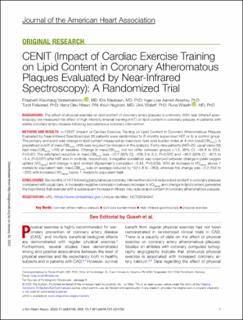| dc.contributor.author | Vesterbekkmo, Elisabeth Kleivhaug | |
| dc.contributor.author | Madssen, Erik | |
| dc.contributor.author | Aksetøy, Inger-Lise Aamot | |
| dc.contributor.author | Follestad, Turid | |
| dc.contributor.author | Nilsen, Hans-Olav | |
| dc.contributor.author | Hegbom, Knut | |
| dc.contributor.author | Wisløff, Ulrik | |
| dc.contributor.author | Wiseth, Rune | |
| dc.date.accessioned | 2023-02-13T12:37:27Z | |
| dc.date.available | 2023-02-13T12:37:27Z | |
| dc.date.created | 2022-08-29T13:59:13Z | |
| dc.date.issued | 2022 | |
| dc.identifier.citation | Journal of the American Heart Association (JAHA). 2022, 11 (10), . | en_US |
| dc.identifier.issn | 2047-9980 | |
| dc.identifier.uri | https://hdl.handle.net/11250/3050394 | |
| dc.description.abstract | Background
The effect of physical exercise on lipid content of coronary artery plaques is unknown. With near infrared spectroscopy we measured the effect of high intensity interval training (HIIT) on lipid content in coronary plaques in patients with stable coronary artery disease following percutaneous coronary intervention.
Methods and Results
In CENIT (Impact of Cardiac Exercise Training on Lipid Content in Coronary Atheromatous Plaques Evaluated by Near‐Infrared Spectroscopy) 60 patients were randomized to 6 months supervised HIIT or to a control group. The primary end point was change in lipid content measured as maximum lipid core burden index at 4 mm (maxLCBI4mm). A predefined cutoff of maxLCBI4mm >100 was required for inclusion in the analysis. Forty‐nine patients (HIIT=20, usual care=29) had maxLCBI4mm >100 at baseline. Change in maxLCBI4mm did not differ between groups (−1.2, 95% CI, −65.8 to 63.4, P=0.97). The estimated reduction in maxLCBI4mm was −47.7 (95% CI, −100.3 to 5.0, P=0.075) and −46.5 (95% CI, −87.5 to −5.4, P=0.027) after HIIT and in controls, respectively. A negative correlation was observed between change in peak oxygen uptake (VO2peak) and change in lipid content (Spearman’s correlation −0.44, P=0.009). With an increase in VO2peak above 1 metabolic equivalent task, maxLCBI4mm was on average reduced by 142 (−8 to −262), whereas the change was −3.2 (154 to −255) with increased VO2peak below 1 metabolic equivalent task.
Conclusions
Six months of HIIT following percutaneous coronary intervention did not reduce lipid content in coronary plaques compared with usual care. A moderate negative correlation between increase in VO2peak and change in lipid content generates the hypothesis that exercise with a subsequent increase in fitness may reduce lipid content in coronary atheromatous plaques. | en_US |
| dc.language.iso | eng | en_US |
| dc.publisher | American Heart Association | en_US |
| dc.rights | Navngivelse-Ikkekommersiell 4.0 Internasjonal | * |
| dc.rights.uri | http://creativecommons.org/licenses/by-nc/4.0/deed.no | * |
| dc.title | CENIT (Impact of Cardiac Exercise Training on Lipid Content in Coronary Atheromatous Plaques Evaluated by Near-Infrared Spectroscopy): A Randomized Trial | en_US |
| dc.title.alternative | CENIT (Impact of Cardiac Exercise Training on Lipid Content in Coronary Atheromatous Plaques Evaluated by Near-Infrared Spectroscopy): A Randomized Trial | en_US |
| dc.type | Peer reviewed | en_US |
| dc.type | Journal article | en_US |
| dc.description.version | publishedVersion | en_US |
| dc.source.pagenumber | 0 | en_US |
| dc.source.volume | 11 | en_US |
| dc.source.journal | Journal of the American Heart Association (JAHA) | en_US |
| dc.source.issue | 10 | en_US |
| dc.identifier.doi | 10.1161/JAHA.121.024705 | |
| dc.identifier.cristin | 2046773 | |
| cristin.ispublished | true | |
| cristin.fulltext | original | |
| cristin.qualitycode | 1 | |

